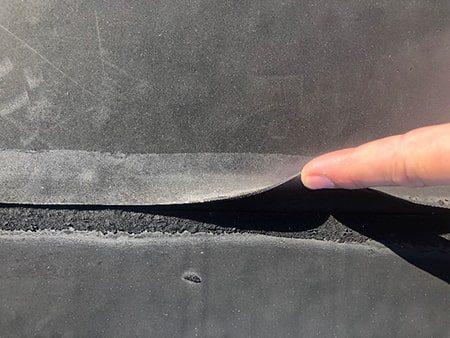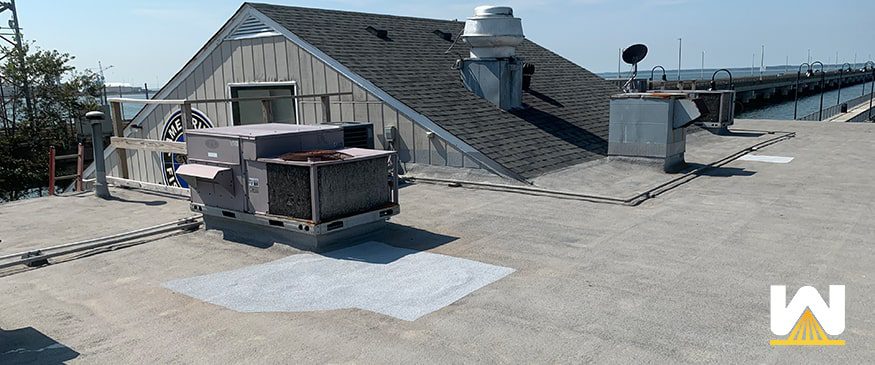Let’s say that you recently had a new commercial roof installed. With commercial roofs costing $4 – $10 per square footage (roughly) and the average-sized commercial roof being around 20,000 square feet, you probably spent around $140,000 for your new roof.
$7 x 20,000 sq. ft. = $140,000.
Now you get an email about roofing maintenance.
You’re probably thinking, “maintenance…sounds like a rip-off deal to me. I just paid $140,000 for a new roof, and now you want more money?”
Or maybe you’re thinking, “I already have a 20-year warranty, so why do I need routine maintenance?”
To anyone not in the roofing industry, routine maintenance kind of sounds like insurance. Something you continually pay for that you never have to use.
But what if we told you that’s not the case.
The best reference to commercial roof maintenance is how you treat your car.
When you buy a car, you have to perform routine maintenance on it…right?
Oil changes, new tires, air filters, etc. All these services need to be kept up or else your new car won’t last very long.
The same is true for a commercial roof. It’s just harder to recognize because the roof isn’t seen every day like your car is.
Outta sight, outta mind, some would say.
In this article, we’re going to explain a few things about roof maintenance:
- What work is performed during routine maintenance?
- How many times per year is roof maintenance recommended?
- How much does roof maintenance cost?
- What would happen if you ignored maintenance on your roof?
- If you ignore maintenance, will it void your warranty?
Let’s get started.
What work is performed during routine maintenance?
Here are the services provided during routine maintenance:
Visual Inspection

A service technician will walk your roof and look for areas that are showing signs of weakness. This could be a seam that is showing signs of lost adhesion. It could be a flashing around a penetration that has a small crack.
Seeing signs of weakness today prevents costly repairs down the road.
Cleaning of Drains and Gutters
A service technician will remove the drains and remove anything blocking water from draining properly. This could be algae build-up, sticks, leaves, etc.
The same is performed for roof gutters. Remove all the sticks, leaves, or anything else that can affect the way water moves on your roof.
These are very important because water needs a clear path to exit your roof. If not, standing water can occur, which reduces the life of your roof, but can also void your warranty (more details on this below).
Repairs
Sometimes after a hailstorm or if a sharp object is dropped on your roof, small repairs need to be made. If you have a spray foam roof, perhaps there’s a small hole or crack that’s occurred. A roofing contractor will cut around that area, dry the area out, and then add caulk or coating into the area and smooth out the surface.
Doing simple repairs prevents damaged areas from getting worse.
Written Report
Once maintenance is complete, a written report will be provided that includes photos of the work performed, what areas we’re keeping a close eye on, and other areas of importance.
For example, a vent hood may have been blown off or bad mortar joints may have been recognized. Photos of these will be included in that report.
How many times per year is roof maintenance recommended?
Roof maintenance is recommended twice per year, once in the fall, after leaves have fallen just before Winter, and once in the spring after all the seedlings have fallen.
Why is this so?
You want to have your roof prepared for the colder months. If your roof has an entry point for water to get into your roof system, that water will freeze during the Winter.
Once the Spring comes and the frozen water thaws, you will be left with an exposed roofing system.
This is because water expands when it’s frozen. When the water thaws out, it leaves behind a larger area than when the water entered.
When the Spring comes, you want to see how the roof made it through the Winter.
If there’s no leaking, great!
But you want to have a professional walk the roof and make sure the roof is performing as it was meant to before the next storm happens.
How much does roof maintenance cost?
A roof maintenance plan usually costs between $0.02 and $0.05 per square foot.
For an average 20,000 sq. ft. roof, the costs would usually be between $400 and $1000.
Here are some factors that influence the cost of a maintenance plan:
The size of the roof
The price per square foot can change depending on size. The bigger the roof is, the lower the cost is per square foot (economies of scale).
The accessibility of your roof
If your roof is very high, such as 10 stories in the air, that roof is harder to access versus a roof where a ladder can be used.
Also, if your roof has multiple levels, such as a school or hospital, these roofs take more time to navigate around the roof, therefore they cost a little more.
The number of penetrations
The more penetrations, the more time it takes to inspect them.
If two roofs are the same square footage, yet one roof has 10 penetrations and the other has 300; it will take more time to inspect the roof with more penetrations.
Location of the roof
The geographic location has an impact on pricing. Some roofs are out of state, which requires travel time and overnight stays at hotels.
Now that you know what causes the price of routine maintenance to go up or down, what would happen if you just ignored maintenance altogether?
What would happen if you ignored maintenance on your roof?
If you choose not to invest in a maintenance program for your commercial roof, then it’s up to you to keep up with the maintenance. If you ignore routine maintenance, the damages will not be covered under warranty.
A common issue is that the roof is ignored, drains get clogged, standing water occurs (which is water that sits on the roof), weather-related damages occur after storms, and others have caused damage.
The roof membrane deteriorates quicker than expected and causes damages that aren’t discovered until water enters the building.
In this scenario, damages would not be covered under warranty.
Here’s a quick video showing a flooded roof, which is what can happen to a roof if the drains are clogged:
Ignoring the maintenance on your roof can cost you more in the long run
We’ve seen time and time again when a spray foam roof is ready to be recoated, that the price to recoat a roof without routine maintenance is around 30% higher than a roof that had at least annual maintenance performed.
If these roofs were 20,000 sq. ft. and the price of a recoat is generally $3/sq. ft., then the cost of a recoat on a roof with routine maintenance would be around $60,000.
Increase this price by 30% for a roof that didn’t have routine maintenance and that cost would be $78,000.
Perhaps you’re thinking, “When I got my new roof, it came with a warranty, so why do I need maintenance? All repairs will be covered with the warranty.”
If you ignore roof maintenance, will it void your warranty?
You don’t need to have routine maintenance with a roofing contractor to keep your warranty intact, but you are responsible for eliminating standing water on your roof.
Standing water will void a warranty.
Here is a line from a warranty contract with a popular roof coating manufacturer about circumstances that void a warranty:
The XXX Roofing System, substrate, or building structure is damaged by ponding water as defined in the National Roofing Contractors Association or as the result of plugged drains and/or scuppers.
So, if you keep a close eye on your roof and keep the drains and scuppers clean, then you’re good to go. But a common issue we see is that the roof is ignored, and only gets attention when water is entering your building.
By this time, it’s usually too late, as standing water has damaged your roof system. These repairs would not be covered under warranty.
What should you do about roof maintenance?
Our advice is to sign up for a routine maintenance package. It will keep your warranty intact; it will save you money in the long run, and it’s one less thing to worry about.
Plus, the liability of having a person or employee that’s not familiar with being on a roof safely can be put on the contractor.
Some building owners don’t want to pay for routine maintenance and that’s ok, you won’t void your warranty, but your roof is something that needs attention BEFORE water is entering your building.
I guess you just need to figure out how valuable your time is.
Some property owners are busy keeping the place 100% occupied. Other building owners are worried about the hundred other problems that go along with running a business.
The best analogy we tell commercial building owners is that roof maintenance is just like doing routine work on your car.
You can certainly maintain your car yourself, but if you don’t keep up with oil changes and new tires, the car won’t last as long as it could.
And if you don’t change your oil, and the engine blows up, it won’t be covered under warranty.
West Roofing Systems has been installing, repairing, restoring, and servicing commercial roofs since 1979. We have a dedicated service team that ONLY does routine maintenance on roofs.
It’s an advantage to have a dedicated service team because we’ll get to know your roof inside and out over the years and will know what areas need special attention, which don’t, what repairs happened last time, etc.
Want to learn more about roof maintenance?
Please watch this video that will address the most popular questions building owners have about roof maintenance:

